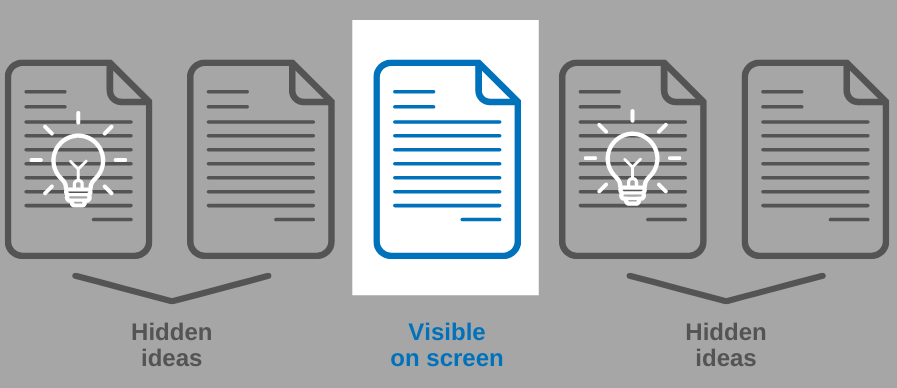
Did you know that the tools you use when brainstorming and planning may be constricting your thinking – forcing it to follow a narrowly proscribed path? It’s true.
The document-based tool you’re using to capture your thinking has some built-in limitations that you take for granted. You don’t even think about them, because they’re practically invisible.
This ubiquitous software application is adequate for communicating information in a linear, structured format. That’s why it’s part of the standard-issue toolkit that’s provided to almost every knowledge worker on the planet.
But what if you need to think more broadly and creatively? What if you need to apply a higher level of thinking to tackle a complex challenge?
You need a better tool.
You need mind mapping software.
The document: A narrow view of your ideas
We’re so used to using tools like Microsoft Word and Google Docs that it no longer occurs to us that we’re only looking at a single page at a time. It’s as if we only have a little viewport on the contents of our document. We can slide it up and down but our view is still only restricted to a single page, as illustrated below:

Why is this important? Let’s say that you’re developing ideas for a new project. You are currently viewing one idea on your computer screen. But a related idea you really need to connect it with that would increase the value of it by 10x is 20 pages later in the document. Realizing that these disparate pieces are even available to connect is almost impossible.
Document-based word processing software also makes it easy to pour your thoughts onto the page in no particular order – but then it lacks tools to help you make sense of it.
Unless you are incredibly rigorous at using descriptive headings, subheadings and other formatting tools, the structure every document is invisible. And that’s a big problem!
You see, it’s next to impossible to look at a document and “see“ the underlying structure of it. It’s lost in sentences and paragraphs. This makes it hard to see if you have a complete “skeleton” so can ask critical questions such as:
- What pieces are missing?
- What related concepts should be connected to each other?
- What other research do I need to do?
- Whose expertise do you need to tap into? What sections are superfluous or duplicate each other?
A real-world example
I recently spoke with an executive from a digital agency who also runs a non-profit focused on a growing branch of marketing technology. He was planning the group’s first event. He shared with me how his strategy of capturing ideas and planning thoughts in a Word document started out fine, but soon became a liability as the document got longer.
He was really frustrated, as well as slightly panicked, as he realized how much he needed to do to get ready for this event, and what a morass of information his Word document had become. He literally didn’t know what to do to extricate himself from the tangled mess he had gotten himself into.
“It has become really hard to find any single piece of information, or to connect related bits together,” he told me. “It’s hard to decipher what elements I have, what state they’re in and what other things I need to think about and plan for,” he added nervously.
7 ways mind mapping software solves these problems
Mind mapping software can help you to consider a broader range of potential solutions, think more deeply and creatively about the challenge at hand, plan more thoroughly and make better-informed decisions. Here’s why:
- It leverages the brain’s powerful associative capabilities to help you see new connections and relationships that weren’t apparent before.
- Its design encourages you to do lateral thinking – which literally means “thinking sideways.” In other words, it helps you break out of your well-worn paths of thinking and explore fertile new areas of promising ideas and compelling possibilities.
- It gives you a powerful way to deconstruct challenges into their component parts so you can explore underlying causes and contributing factors – giving you new insights into what the root problem or cause is and how to solve it.
- It enables you to organize and reorganize your thoughts and ideas with almost complete freedom, until the make the most sense to you.
- You can add icons, symbols and other types of formatting to selected topics of a mind map to give them meaning and context – extremely valuable for sense-making.
- You can expand and collapse map branches and filter its content based on various criteria. This enables you to control how much information you’re viewing at any given time, helping you reach clarity faster. For example, my friend could filter an event planning map to display only sponsorship-related topics, or only overdue tasks.
- Mind mapping software a powerful platform for brainstorming ideas, organizing and evaluating them and then developing implementation plans for the most promising ones.
Using mind mapping software for thinking, brainstorming and planning enables you to remove the chains from you mind and think more fluently. That can make a big impact on your ability to generate and implement effective solutions.

Leave a Reply